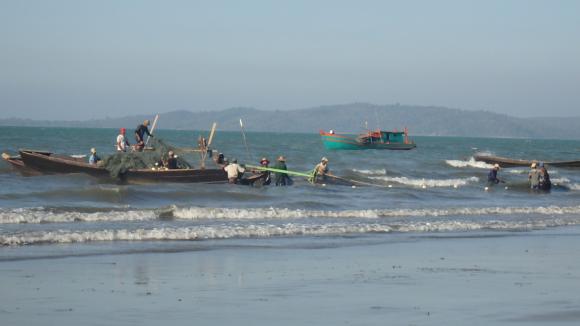မြန်မာစာထည့်ရန်
Under the adaptation alternative scenario, this ‘fisheries’ component, together with DOF and partners, adopts good practices in participatory appraisal and risk analysis, to identify their vulnerability to climate change impacts, develop, and implement adaptation action plans and through agreed on appropriate priority adaptation actions. This component will build on the successful fisheries co-management experiences of the Government of Myanmar to further develop community-based climate change adaptation and disaster risk planning with the EAFM approaches in order to reduce underlying vulnerability of communities.
Using good practice in climate vulnerability assessment the component will develop and build capacity in the participatory climate vulnerability assessment. This process will ensure gender-specific vulnerabilities throughout the production chain be identified. These assessments will be part of a new EAFM-CCA planning approach. They will be undertaken initially in the 9 pilot fishing communities identified. The community level climate change vulnerability assessments for the fisheries sector in targeted coastal and inland regions will inform community - based adaptation planning and identify adaptation actions.
Training modules (Ecosystem Approach to Fisheries Management, Safety at Sea and Post – harvesting modules) will be developed for DOF and partner staff implementing the EAFM-CCA and EAA-CCA approach and also to inform decision makers and lawmakers. In addition, capacity needs assessment will be conducted to focus on strengthening institutional capacities such as coordination mechanisms as well as organizational capacities including strengthening fisheries and aquaculture networks. The project will integrate effective capacity development practices to enhance capacities across the individual, organizational, and enabling environment.
The Fisheries Component also supports to establish the fisheries management units (FMUs); these communities will also develop and implement fisheries climate change adaptation and disaster management plans and further build their resilience. These plans will be developed using best practice in community and stakeholder consultation, the ecosystem approach to fisheries and aquaculture, and support the participation of women and other vulnerable groups in the processes.
The main livelihood problems for fishers are lack of investment for replacement of fishing gear and repairing fishing boats. The fishers are already vulnerable to storms and natural disasters and need good early – warning system. They want to learn about new fishing technique and post-harvest technology to improve their livelihoods since they are now using traditional fishing method and practices.
A wide range of socio - economic issues are still needed to be addressed including food insecurity, lack of drinking water, land tenure, poor access to training and extension services, limited empowerment and participation of women, children dropping out of school, no regular employment and lack of loans. To deal with these, the EAFM CCA approach will enable the communities to address these issues:
- New fisheries management measure to address climate change impacts could include preventing fishing during climate induced droughts or changing the closed seasons to reflect changes in species or their life cycles;
- For coastal communities, changes to the management of fisheries need to be agreed with communities;
- Establishing co management regimes; and,
- Protecting vulnerable ecosystems and habitats that provide protection to extreme events.
These will be done through the development and implementation of climate change adaptation and disaster risk management plans for the fisher and fish farming communities that rely on the ecosystem services provided by coral reef/seagrass/mangrove-fishery-aquaculture systems. The project will work with fishers, communities, local NGO, local universities, and government agencies to develop community-based early warning systems to jointly monitor and communicate changes in the environment.
2019 HighlightsWith defining the coastal module as a backbone, the Ecosystem Approach to Fisheries Management EAFM capacity plus training modules were developed on inland fisheries, irrigation, small – scale fisheries, co-management and CCA/DRM.
Regional/ State level (Yangon, Ayeyarwaddy and Rakhine) EAFM training was conducted on Sep and Oct 2019. In these trainings, FishAdapt encouraged the IFT staffs as a main trainer in some sessions and facilitated as co-trainers along the training. Participants include the representatives from DOF, Department of Rural Development (DRD), Environment Conservation Department (ECD), Universities, CSOs and INGOs in these Regional/ State level EAFM trainings. With support from the implementing partners (NAG in Yangon, Ayeyarwady and RCA in Rakhine), community mobilization process orientation workshops have been conducted in the first batch targeted fishing communities. In this community mobilization process, a series of activities such as identifying threads and issues in their community, community representative committees formation, actionable information data collection and participatory mapping for fishing ground were undertaken. Community Representative Committees (CRC) were established in Yangon Region, and in Rakhine State. Each committee was formed with 50% women participation and the selection criteria was based on the community. Executive Committee of four representatives (chairperson, vice-chair, secretary and treasurer) and a gender and communication focal person was created, with roles and responsibilities defined. Capacity building of Community level EAFM/EAAM training was also conducted in IFT in December 2019. Representatives from implementation units in Yangon and Ayeyarwady Region were trained on how to create the visual aid, training design and the simplest way to develop community EAFM plan in order to carry out the community level training in their respective communities in the regions. |








